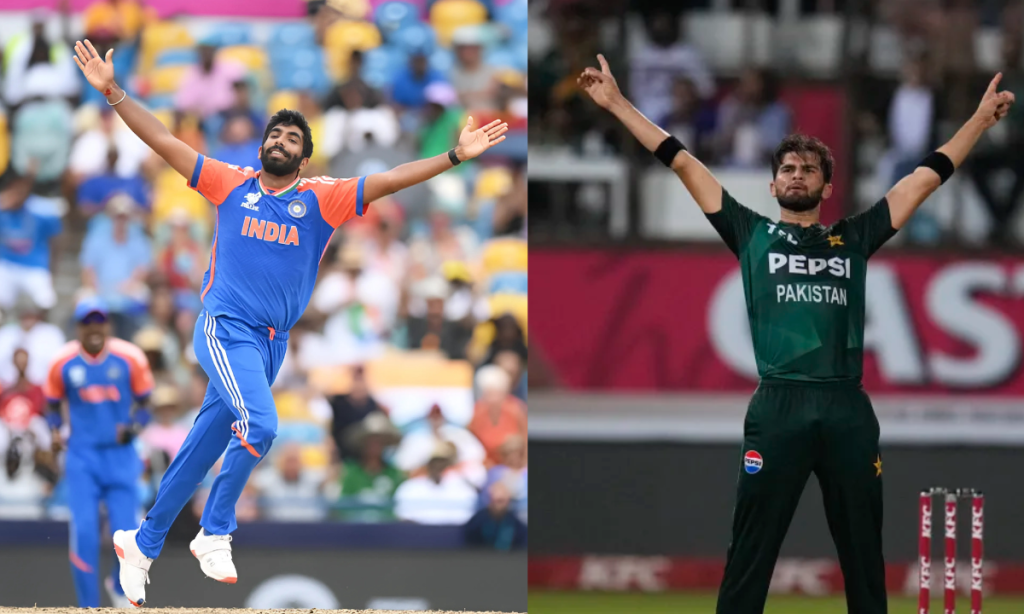The cricketing world eagerly anticipates the ICC Champions Trophy 2025, where India, hosting their matches in Dubai, will face off against Pakistan, Bangladesh, and New Zealand in their group.
One of the key battles will be between the fast bowling duo of Jasprit Bumrah from India and Shaheen Afridi from Pakistan.
Both have been instrumental in their teams’ strategies, but who has the better stats in ODIs to potentially sway this tournament in their favor?
Jasprit Bumrah
Jasprit Bumrah has emerged as one of the most reliable and feared bowlers in world cricket, especially in the 50-over format.
With 89 matches under his belt, Bumrah has bowled 4580 deliveries, conceding 3509 runs while capturing 149 wickets.
His best performance stands at an astonishing 6/19, with a career average of 23.55 and an economy rate of 4.59. His strike rate is 30.7 balls per wicket, indicating a consistent ability to take wickets without being overly expensive.
Bumrah’s bowling arsenal includes a lethal inswinger, a deceptive slower ball, and pinpoint yorkers, making him a nightmare for batsmen in all phases of the game.
His economy rate is particularly significant in ODIs, where controlling the run rate can be as crucial as taking wickets.
For a tournament in Dubai, where pitches tend to be flat, Bumrah’s ability to bowl defensively when needed, especially in the middle overs, could be a key factor for India.
Shaheen Afridi
Shaheen Afridi, on the other hand, has quickly become Pakistan’s pace spearhead. With 59 matches, Afridi has bowled 3006 balls, given away 2754 runs, and taken 119 wickets.
His best figures are 6/35, with an average of 23.14 and an economy rate of 5.49. His strike rate of 25.2 is impressive, showing he can take wickets at a faster pace than Bumrah.
Afridi’s height and natural pace allow him to generate bounce and movement that can unsettle even the best of batsmen.
His ability to swing the new ball, combined with his effectiveness with the old ball, makes him a versatile bowler.
However, his economy rate is higher than Bumrah’s, suggesting he can be more costly, particularly if batsmen get on top of him.
In Dubai, where the ball might not assist bowlers as much, Afridi’s pace could still be a significant weapon, especially if he can adapt his lengths to exploit any reverse swing.
When comparing these two bowlers’ ODI statistics:
Average: Both bowlers have very close bowling averages, with Afridi at 23.14 and Bumrah at 23.55. This closeness indicates that they are both effective in terms of how many runs they concede per wicket.
Economy Rate: Here, Bumrah has a noticeable advantage with an economy rate of 4.59 compared to Afridi’s 5.49. This suggests that Bumrah is better at keeping runs down, which can be crucial in setting or defending scores.
Strike Rate: Afridi leads in this aspect with a strike rate of 25.2 compared to Bumrah’s 30.7. This means Afridi tends to take wickets more frequently, potentially disrupting batting line-ups quicker.
Best Performances: Both have had standout performances, with Bumrah’s slightly better best figures indicating his potential for match-winning spells.
Experience: Bumrah’s 30 more matches give him an edge in terms of experience, particularly in handling various conditions and pressure situations.
In the context of the Champions Trophy 2025 in Dubai, where the pitches might not offer as much assistance to bowlers, Bumrah’s control over the game’s tempo through his economy could be more valuable.
His ability to bowl at all stages of the innings with effectiveness might give India a slight upper hand in managing innings, especially in tight games.
However, Afridi’s raw pace and his knack for taking wickets in clusters can’t be underestimated; his performances could turn matches in Pakistan’s favor, particularly if the ball starts to reverse.
In Summary
Deciding who has better stats between Jasprit Bumrah and Shaheen Afridi in ODIs involves looking beyond mere numbers to understand their impact on the game.
Bumrah’s economy and versatility across all phases of the game slightly edge him as the more complete ODI bowler, particularly for conditions like those expected in Dubai.
However, Afridi’s ability to take wickets at crucial times and his raw pace make him a game-changer, especially in knockout cricket where one or two pivotal performances can define a tournament.
As fans and analysts look forward to the Champions Trophy, the performances of these two bowlers will be crucial.
Their head-to-head battles, both in direct confrontations and through their overall impact on their teams’ performances, will be a highlight of the competition, potentially deciding the fate of not just matches but the tournament itself.

